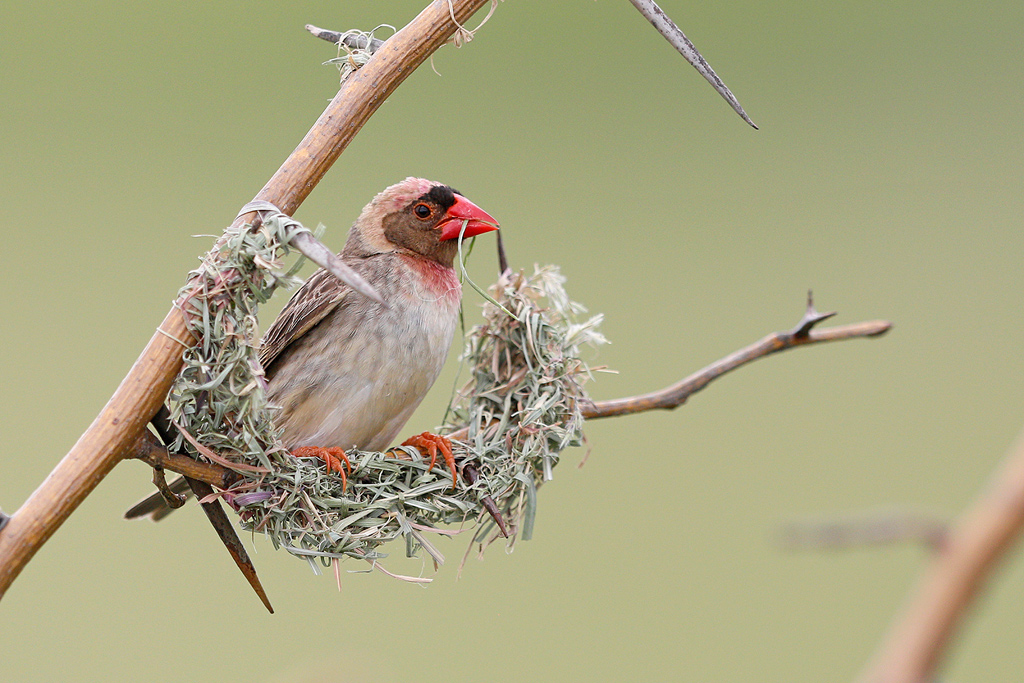The red-billed quelea is a small passerine noted for its colorful feathers and bright red bill. It is also known as the weaver bird. It is a sociable bird that travels in huge flocks of up to 30 million members. The bird is native to the sub-Saharan region of Africa.

Quelea Scientific Name
Its scientific name is Quelea quelea. The pronunciation is KWEE-LEE-AH. Other names for this bird are the weaver bird, red-billed weaver, or red-billed dioch.
Amazing Facts
- There are more red-billed queleas than there are any other birds in the world.
- Males build the nests and use their nests to attract females.
- They eat half their body weight in grass and seeds daily.
- They are known as “Africa’s feathered locusts” because they are so destructive to crops.
There are three subspecies of the red-billed quelea:
quelea quelea
quelea aethiopica
quelea lathamii
Quelea Appearance
A red-billed quelea is a small bird about the size and shape of a swallow. It is about 5 inches long and typically weighs just under one ounce. It has a heavy, cone-shaped bill that can range from red to orange.
Most males have black masks, and a few have white masks. Around the mask, the feathers may be yellow, red, pink, or lavender. The bird’s upper body has brown and white feathers, and its flight feathers may be green or yellow. The male sports bright colors during the mating season. During non-breeding seasons, the bill may turn pink or orange.

Females also have red bills, but they don’t have the facial masks that males wear. As in most bird species, the males are more brightly colored than females.
Behavior
Queleas are highly social birds. They travel, nest, and feed in large flocks known as colonies. These flying flocks can reach 30 million birds or more. Together, they descend on farm fields and eat grass seeds.

When in their flocks, they make a large sound caused by thousands of beating wings. Both males and females sing, and their call sounds like they’re saying, “Tweedle-toodle-tweedle.”
Quelea birds have been compared to locusts because they eat seeds and cereal crops. Farmers have tried to control them using different measures, but the birds continue to outgrow these attempts by reproducing in enormous numbers.
In 2021, these birds destroyed several hundred acres of rice farms in Uganda. One farmer reported that her crops were wiped out just three weeks after the birds arrived.
Quelea Habitat
The red-billed quelea is native to sub-Saharan Africa, and it has a wide distribution in most of the continent. It is abundant in Angola, Botswana, Cameroon, Ethiopia, Gabon, Kenya, Malawi, Tanzania, and Zimbabwe.
This bird prefers a dry, grassy environment. It can be found in the bush, grassland, and savannah regions.
Quelea Diet
Red-billed queleas are omnivores who eat grass, seeds, and cereal crops, including wheat, rice, and corn. Among the crops they have been recorded eating are:
Barley
Buckwheat
Bulrush (pearl millet)
Foxtail
Finger millet
Rice
Sorghum
When preparing to migrate, they supplement their diet with insects, which are higher in calories than seeds. The extra calories give them the fat reserves they need to make the long journey to warmer weather. They travel from 190 to 370 miles during their annual migration.

They prefer to hunt for food in their native habitat of the forest, scrubland, and grassland, but they will invade human farms when their food sources run out. For this reason, queleas are hated and feared by African farmers, especially small-scale farmers who can’t afford expensive methods of bird control.
The birds are voracious. They feed from dawn to dusk. As one expert found, the average weaver bird can eat roughly half its body weight daily in grains, so 2 million flocking birds can eat 20 tons of grain in a single day.
Quelea Predators and Threats
The quelea has many natural predators. They include owls, snakes, squirrels, monkeys, foxes, lions, and leopards. All these animals and others feed on the birds. Bird species that eat queleas include the tawny eagle and marabou stork.
Humans are also threats. Farmers try to protect their crops by destroying large numbers of quelea birds. Despite these efforts to control their population, the birds have a persistent presence in most African countries.
Many people in Africa also eat these birds, and many of them are caught and sold for food at African markets every week.
Quelea Reproduction and Life Cycle
These birds breed communally, flocking together to share resources and nesting sites. They typically build their nests in thorn trees, but they occasionally use sugar cane or other plants. Their colonies can be huge. A large colony in Zimbabwe, for instance, had 10,000 nests per acre. Scientists also counted more than 6,000 nests in one tree.
After the birds mate, the female lays her eggs in the nest. Each clutch can range from 1 to 5 eggs, but it typically has 3. After 10 to 12 days, the nestlings emerge from the eggs. They are born with white bills and barely any feathers. Their eyes open a few days later. Both parents feed the babies for about 10 days. After that, the babies leave the nest and fly on their own.
The hatchlings molt every few months. At 5 months, their plumage colors resemble those of their parents. They reach sexual maturity in one year.
They live 2 to 3 years in the wild.
Nests
Unlike other bird species, males take a leading role in nest-building duties. Only males build the nests, and they can take two to three days to finish them. When the male finishes, he displays his colorful plumage and his nest to attract females.



